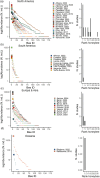Examining Honeybee (Apis mellifera) Dominance Patterns Within Urban Bee Communities Worldwide
- PMID: 40809827
- PMCID: PMC12350035
- DOI: 10.1002/ece3.71979
Examining Honeybee (Apis mellifera) Dominance Patterns Within Urban Bee Communities Worldwide
Abstract
Urban ecosystems can host diverse bee communities. However, the increasing prevalence of urban honeybees (Apis mellifera Linnaeus 1758) raises concerns about their ecological impact. Using a systematic review of published studies, we obtained 68 datasets representing 46 cities in 15 countries and five continents to test the extent to which honeybees are dominant in urban bee communities worldwide. Honeybees ranked as the most abundant species in ca. 70% of the datasets and accounted for more than 10% of all individuals in ca. two-thirds of the datasets. Moreover, honeybees ranked among the top three abundant species in 70% of studies. Honeybee abundance patterns were consistent across regions and sampling designs, independent of whether honeybees were native or not. At the same time, the degree of dominance varied across cities. These findings highlight the need to address the ecological implications of honeybee dominance, including assessing the effects on wild bee communities and populations and defining strategies to enhance, preserve wild bees, and enhance coexistence with honeybees.
Keywords: Anthophila; Western European honeybee; bees; diversity distribution; urban beekeeping; urban ecosystems.
© 2025 The Author(s). Ecology and Evolution published by British Ecological Society and John Wiley & Sons Ltd.
Conflict of interest statement
The authors declare no conflicts of interest.
Figures



Similar articles
-
Prescription of Controlled Substances: Benefits and Risks.2025 Jul 6. In: StatPearls [Internet]. Treasure Island (FL): StatPearls Publishing; 2025 Jan–. 2025 Jul 6. In: StatPearls [Internet]. Treasure Island (FL): StatPearls Publishing; 2025 Jan–. PMID: 30726003 Free Books & Documents.
-
A systematic review of honey bee (Apis mellifera, Linnaeus, 1758) infections and available treatment options.Vet Med Sci. 2023 Jul;9(4):1848-1860. doi: 10.1002/vms3.1194. Epub 2023 Jun 19. Vet Med Sci. 2023. PMID: 37335585 Free PMC article.
-
Are you my mother? When host genetics and gut microbiota tell different phylogenetic stories in the Africanized honey bee hybrid (Apis mellifera scutellata × sspp.).Microbiol Spectr. 2025 Jul;13(7):e0247524. doi: 10.1128/spectrum.02475-24. Epub 2025 May 28. Microbiol Spectr. 2025. PMID: 40434076 Free PMC article.
-
Comparison of the Sensitivity of Tetragonisca angustula (Apidae-Meliponini) and Apis mellifera (Apidae-Apini) to Three Insecticides (Malathion, Imidacloprid, and Fipronil) Used in Costa Rica.Environ Toxicol Chem. 2023 May;42(5):1022-1031. doi: 10.1002/etc.5587. Epub 2023 Mar 23. Environ Toxicol Chem. 2023. PMID: 36807197
-
Behavioral interventions to reduce risk for sexual transmission of HIV among men who have sex with men.Cochrane Database Syst Rev. 2008 Jul 16;(3):CD001230. doi: 10.1002/14651858.CD001230.pub2. Cochrane Database Syst Rev. 2008. PMID: 18646068
References
-
- Ackerman, J. D. 2021. “Island Invasions by Introduced Honey Bees: What Can be Expected for Puerto Rico and the Caribbean?” Frontiers in Ecology and Evolution 8: 556744.
-
- Aronson, M. F. , Lepczyk C. A., Evans K. L., et al. 2017. “Biodiversity in the City: Key Challenges for Urban Green Space Management.” Frontiers in Ecology and the Environment 15: 189–196.
-
- Baldock, K. C. R. 2020. “Opportunities and Threats for Pollinator Conservation in Global Towns and Cities.” Current Opinion in Insect Science 38: 63–71. - PubMed
LinkOut - more resources
Full Text Sources

